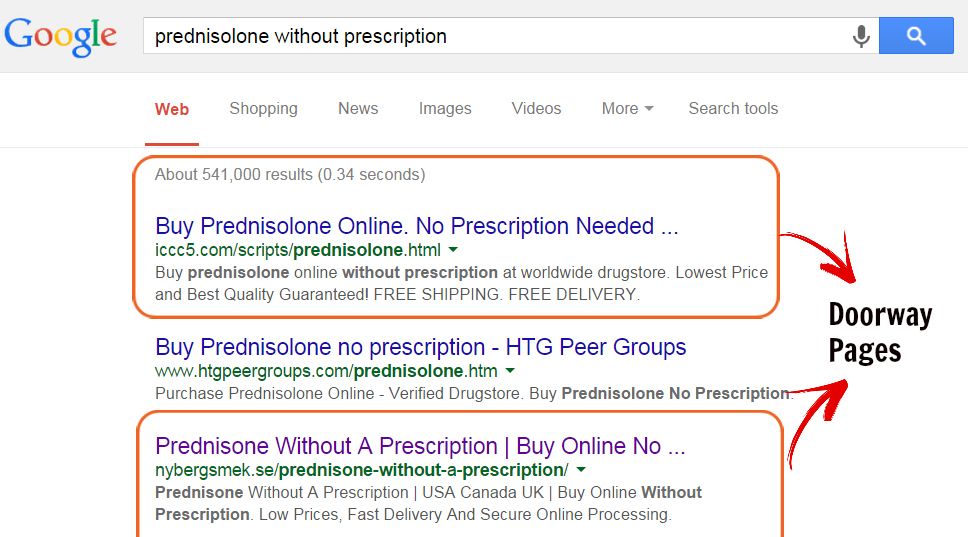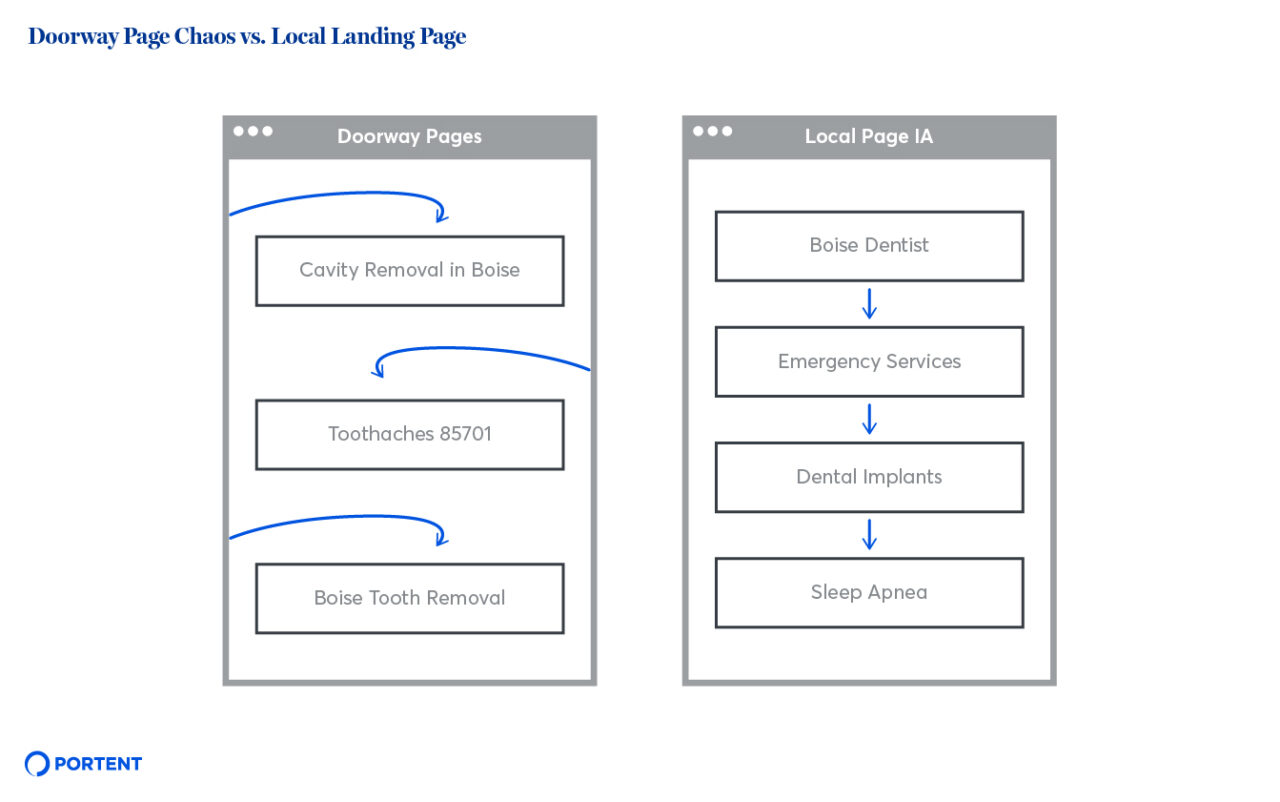Are you seeking answers to the question, “what are doorway pages in SEO“? Or are you looking at using a doorway page as a way to boost SEO? Or perhaps wondering if you should be using doorway pages to improve your ranking?
The short answer to that question is “don’t”. Doorway pages were relevant during the early 2010s but were only beneficial to the website and not to the users.
Before 2015, it was commonplace to find doorway pages since it was a go-to way of boosting website ranking. However, they grow unpopular today with the coming of changes to how search engines function.
To understand the in-depth nuances behind these pages, read on ahead.
What are Doorway pages in SEO?
Doorway pages are web pages that try to create a high-ranking page by only ranking for similar keywords and specific keywords. They are of little value to users since it is the same content from multiple doorway pages.
To elaborate, multiple sites or multiple pages pop up in user search results. The pages direct users to essentially the same destination from different locations. Such an SEO practice of creating multiple domain names to support the same content is collectively known as doorway pages.
Thus, the practice of a doorway page is to give the impression that the website forms a part of the highly relevant results. The inference of this impression is that the website is worth a high ranking.

However, this form of ranking adjustment, where similar pages attest to the same content, is unfavorable for users. Additionally, these pages, at times, redirect users to substantially similar pages that contain keyword variations and keyword phrases that are of little value.
Is a Doorway page the same as a Location Page?
There is a core difference between the two types of web pages. The difference, however, is similar to taking a knife to a gunfight.
Understanding Location/Landing pages
The web pages that a user lands on before entering the website are known as landing pages. Users can reach these pages via several marketing funnels that include paid search terms, social media ads, organic traffic from social media, and organic search.
Additionally, these pages adhere to Google’s guidelines and thus to other search engines and their instructions.
Moreover, location is a good way to develop multiple landing pages. For example, the search query for renting a cycle in Brighton will have similar results to a search query for renting a bike in Leeds.
Thus, creating pages with location specificity improves clarity. The content on these landing pages is actual usable content, which will funnel users into the main website. So, functioning in multiple locations leads to the need to have multiple landing pages.
So, in short, funneling visitors from call-to-action product pages with the actual content of specific regions has a unique value.

Pro tip: Craft landing pages with a simple call-to-action with up-to-date information and minimal links to avoid getting a Google penalty.
Landing pages Vs. Doorway pages
In contrast, a doorway page is nothing more than an attempt to create multiple pages with specific keyword phrases. Users gain nothing new from the different pages since they are similar to the actual website.
The difference between Landing Page and Doorway Page thus can be outlined as:
- A doorway page does not have a seamless user experience and will not funnel visitors to the entire website.
- Doorway pages also utilize practices such as keyword stuffing to maximize the abuse of keyword phrases.
- Usually, a doorway page will not have a call-to-action and instead have an excess number of links.
- The final destination for a landing page is the actual website. In contrast, the point of doorway pages is to have duplicate content with little to no unique value.
- Unlike a doorway page, a landing page provides useful information to a user.
- The information available on a doorway page is usually haphazard. In comparison, the information on landing pages has a proper structure.

The usage of landing or location pages is a highly beneficial digital marketing process and proper execution of the same can lead to minimal Google penalties, especially, due to the improvements to the structuring of the site.
So, when a user is looking for specific search queries, a search engine has to have the capacity to direct them to a site with unique content with high value. The broad impact of such a process has effectively ensured the use of doorway pages to acquire more traffic as a redundancy.
Types of Doorway pages
There are no categories or types of doorway pages.
The click-bait articles that popup stating that there are good ways to include a doorway page is nothing but keyword stuffing. These articles claim that well-established doorway campaigns alongside good examples of doorway pages exist. Additionally, they state that they perform much better than a page with a listing on Google maps and an e-commerce site.
But in reality, these articles tend to end up with no clear example and a suggestion from a different digital marketing approach. So the safest way forward is to utilize White Hat SEO methods, which will take you 3 to 6 months of a solid investment.
Remember knowing the difference between White Hat and Black Hat SEO is vital to reaping the benefits of SEO.
Examples of Doorway pages
There are situations where some other pages look similar to a doorway page. For instance, the landing or location page is often mistaken for a doorway page.
It is hence vital to understand what are doorway pages in SEO. To help you with this, listed below are some clear examples of doorway pages:
1. Content similarity: These are sites with similar variations and interchangeable content but indexed separately with a below-par user experience.
2. Using different domains: Redirecting a user from different web pages such as franchises, branches, and divisions to the same site.
3. Different location-specific domains: Multiple domains across a geographical pool of target locations to redirect visitors to the same final destination.
4. Redirection: These pages are created to redirect the visitors to a different page.
5. Similarity and lack of browsable hierarchy: Suspiciously similar sites without a clear browsable hierarchy popping up closely on Google search results or in another search engine.

Explanation with a scenario
Say you are creating a website with the main content being “5 Best Gardening Tools”. And you create pages, domains, subdomains, and subfolders such as “5 Best Gardening Tools in Manchester” or “5 Best Gardening Tools in Newcastle” or create a website with slight keyword variation in the form of “5 Best Gardening Equipment” with the sole intention of redirecting traffic back to your initial website; then these sites are doorway pages.
They don’t provide the user with any new content and are only present to help you increase website traffic. As such, adopting such an approach to SEO will likely result in penalization by Google Search and potentially expelling the site.
How to find Doorway pages on your site?
By now, you should have a clear understanding of what are doorway pages in SEO. But also know that Google and other search engines have specific algorithms looking for intricate aspects when dealing with a doorway page.
Indicators of a Doorway page
The aspects that indicate the presence of a doorway page and the questions you should be asking yourself:
1. Purpose of the site: Ask yourself if the website enables organic growth through a high-quality user experience? Or is the purpose of the site to generate high search rankings?
2. Dissonance between content and keywords: Is the single-page content ultra-specific, but the on-page keywords very generic?
3. Location repetition: Do you have two pages or more that serve as a way to redirect visitors to the same page of content? Is geographic location the only difference between them?
4. Lack of navigation: Is your site full of links? Is it easy to navigate between sub-sections, or is it only there to redirect the user to a different page?
Look for these indicators when assessing your web page. Google and other search engines will be looking at these aspects when determining whether there are doorway pages.
Your site will perform poorly on search rankings if you have any or all of these aspects. There is a high chance of Google blacklisting your web page for doorway pages, even if there is just one page.
Removing a Doorway page from your site
To reap the benefits of your SEO strategy, you will need to avoid having a doorway page. So, if you are looking to perform well on a search engine like Google, then it is imperative to ensure that you don’t face any Google penalties.
Be it one page or multiple doorway sites, removing them is vital. To do so, some of the easily manageable methods are:
1. Avoid creating multiple domains: The go-to strategy for you, to begin with, is to avoid creating different domains for the same content, especially with companies having multiple sites spread across franchises, branches, sections, product lines, etc.
2. Abstain from content duplication: To Google and other search sites, minimal content variation between sites indicates a doorway page. Google will immediately flag this as a violation, which leads to significant repercussions.
3. Improve site’s navigation: Fleshing out your site’s navigation is critical to managing the doorway situation and improving the overall UX. So, avoid using a gateway page since they lead to complex digital pathways.
You would instead want the navigation and form of your site to be seamless.
4. Use long-tailed keywords: Identify essential goals and objectives that you want to reach. Develop a keyword strategy that focuses on these goals and objectives. Utilize long-tailed keywords to be specific to the content and not towards the broader keyword spectrum.
The bottom line
A doorway page was commonplace in SEO strategies for years. But with one update, Google essentially made doorway pages an obsolete construct. They now form a part of Black Hat SEO techniques.
So, the core takeaway for companies and individuals looking to get on the SEO bandwagon is to keep user experience in mind. Google ensures that the user comes first and that searches are relevant, accurate, and valuable.
In short, using a doorway page to increase your site’s ranking is no longer an option. Instead, you can look to maximize the potential of SEO by tapping into resources such as Yoast, Ahrefs, and Etsy. Additionally, maximize the potential of SEO by tapping into resources such as Yoast, Ahrefs, and Etsy.



